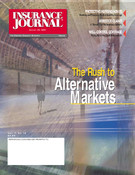Sometimes less does mean more. While there were fewer catastrophes for the second quarter of 2001 compared to recent years, the damage that those left in their wake was enough to send a number of insurers scrambling to cover for losses.
All told, Allison will likely cost insurers in the area of $1.2 billion, according to figures released by Insurance Services Office Inc. All storms totaled together to date are expected to cost insurers around $4.4 billion, resulting in the fourth most costly quarter for insurers on record.
What made the second quarter of 2001 interesting was that it went on record tying the second quarter of 1997 for the least amount of catastrophes: nine. Those nine, however, amounted to a second quarter that was the second worst in losses in the last decade.
Catastrophe losses for the first six months of 2001 currently sit at $5.1 billion. Losses a year ago during the same time period amounted to $3.4 billion.
SAFECO, Allstate Corp., Chubb, and The St. Paul Companies are among the major insurers who are seeing their second-quarter profits eroded by spring hailstorms and Tropical Storm Allison.
Allstate led the way with a total figure of more than $500 million in claims related to catastrophes. Chubb chimed in with $80 million in losses, with St. Paul reporting pre-tax catastrophe losses of $69 million.
The trouble for SAFECO began back in April when a hailstorm pounded the St. Louis area, costing the company $60 million in claims. Two months later, Allison lashed out at Texas, Louisiana, Pennsylvania and a dozen other states, resulting in lost profits of several million dollars for the company.
The storms also included June hailstorms that hit North Dakota along with other areas of the Midwest and Colorado, adding $415 million to the quarter’s catastrophe damages. Texas took on the largest insured-property losses for the second quarter at $1.4 billion, with Missouri next at $1.25 billion.
According to Michael Murray, assistant vice president, financial analysis, for ISO, the company pulled out second-quarter catastrophe losses year by year, going back to 1949, then inflation-adjusted the threshold used to define catastrophic events.
“When we get through all that analysis, second-quarter 2001 had the second highest amount of inflation-adjusted catastrophe losses for any second quarter since 1949, having been only surpassed by second quarter 1998,” Murray said.
As Murray pointed out, catastrophe losses in the first quarter of this year were only $705 million, an unusually low figure. “We combined the data for the first and second quarters to try and figure out if the good experience in the first quarter offsets the bad experience in the second quarter. When we did that, what we found is that the first half of 2001 was the fifth worst first-half of any year since 1949 on an inflation-adjusted basis. We also found that the four years that were worse all occurred in the 1990s (’92, ’94, ’98 and ’99).”
What does the remainder of the year hold for insurers?
“It is a little too soon to tell if we’re going to have a better or worse than average hurricane season, but we are in the hurricane season and that is a concern,” Murray commented.
“There are very clear demographic shifts where an increasing proportion of the U.S. population is living in catastrophe-exposed areas. From the projections we’ve seen, that is apt to increase. The potential is there and insurers and populations they serve need to be ever vigilant.”
Topics Catastrophe Carriers Profit Loss Windstorm
Was this article valuable?
Here are more articles you may enjoy.


 German Insurtech Wefox to Replace CEO After Board Rejects Mubadala Sales Plan
German Insurtech Wefox to Replace CEO After Board Rejects Mubadala Sales Plan  US Judge Skeptical of Biden Overtime Pay Rule
US Judge Skeptical of Biden Overtime Pay Rule  Home Insurance at $10,000 a Year Shows California Buyers’ Pain
Home Insurance at $10,000 a Year Shows California Buyers’ Pain  US P/C Insurers Post Best Q1 Underwriting Result In 17 Years
US P/C Insurers Post Best Q1 Underwriting Result In 17 Years 


